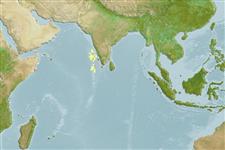Élasmobranches (requins et raies) (sharks and rays) >
Torpediniformes (Electric rays) >
Narcinidae (Numbfishes)
Etymology: Benthobatis: Greek, benthos = depth of the sea + Greek, batis, -idos = a ray (Raja sp.) (Ref. 45335); moresbyi: Named for Capt. Moresby of the Indian Navy..
More on author: Alcock.
Environment: milieu / climate zone / depth range / distribution range
Écologie
marin bathydémersal; profondeur 787 - 1071 m (Ref. 48493). Deep-water; 15°N - 5°N, 49°E - 77°E (Ref. 114953)
Indian Ocean: Arabian and Laccadive seas (off Travancore coast), Yemen and Somalia; including India (Ref. 118627).
Taille / Poids / Âge
Maturity: Lm ? range ? - ? cm
Max length : 35.1 cm TL mâle / non sexé; (Ref. 48493); 39.2 cm TL (female)
Description synthétique
Morphologie | Morphométrie
Dark brown dorsal and ventral surfaces; ventral entirely dark. Snout elongated, usually more than 1/3 in disc length (preocular snout region 40% in disc length in lectotype). Disc oval, longer than wide. Dorsal fins with long, fleshy bases which are much longer than height of the fin (dorsal fin length 50-55% of fin height). Origin of first dorsal well anterior to posterior tip of pelvic fins, close to mid pelvic length; dorsal fins close together, interdorsal space less than length of dorsal bases. Distance between second dorsal and caudal fins much smaller than length of base of second dorsal fin. Caudal fin extremely elongated, reaching almost 1/2 tail length as measured from posterior tips of pelvic fins; caudal fin length 40.4% of distance between cloaca and caudal fin tip (Ref. 48493).
A benthic species on continental slope. Probably suction feeds on bottom-dwelling invertebrates based on its oral morphology. Biology little known. Maturity size uncertain, probably close to 18 cm TL in males (Ref. 114953).
Life cycle and mating behavior
Maturité | Reproduction | Frai | Œufs | Fécondité | Larves
de Carvalho, M.R., 1999. A synopsis of the deep-sea genus Benthobatis Alcock, with a redescription of the type species Benthobatis moresbyi Alcock, 1898 (Chondrichthyes, Torpediniformes, Narcinidae). p. 231-255. In Séret B. & J.-Y. Sire [eds]. Proc. 5th Indo-Pac. Fish Conf., Noumea, 1997. (Ref. 48493)
Statut dans la liste rouge de l'IUCN (Ref. 130435)
Menace pour l'homme
Harmless
Utilisations par l'homme
Plus d'informations
Taille/ÂgeCroissanceLongueur-poidsLongueur-longueurFréquences de longueursMorphométrieMorphologieLarvesDynamique des populations larvairesRecrutementAbondanceBRUVS
RéférencesAquacultureProfil d'aquacultureSouchesGénétiqueElectrophoresesHéritabilitéPathologiesTraitementNutrientsMass conversion
CollaborateursImagesStamps, Coins Misc.SonsCiguateraVitesseType de nageSurface branchialeOtolithesCerveauxVision
Outils
Articles particuliers
Télécharger en XML
Sources Internet
Estimates based on models
Preferred temperature (Ref.
123201): 2.7 - 6.7, mean 6.3 °C (based on 5 cells).
Phylogenetic diversity index (Ref.
82804): PD
50 = 0.5625 [Uniqueness, from 0.5 = low to 2.0 = high].
Bayesian length-weight: a=0.01175 (0.00476 - 0.02897), b=2.88 (2.66 - 3.10), in cm total length, based on LWR estimates for this (Sub)family-body shape (Ref.
93245).
Niveau trophique (Ref.
69278): 3.3 ±0.4 se; based on size and trophs of closest relatives
Résilience (Ref.
120179): Faible, temps minimum de doublement de population : 4,5 à 14 années (Assuming fecundity<100).
Fishing Vulnerability (Ref.
59153): Low to moderate vulnerability (29 of 100).
